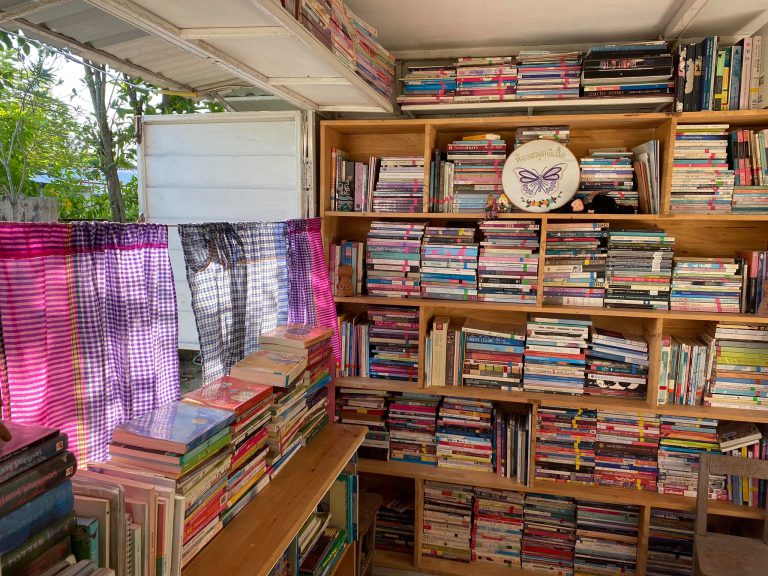Story: Woraphong Wechamaleenonda
In the Yellow Robe Collective’s first year, volunteers cared for hospitalized end-stage patients and visited end-stage patients at home at the hospital’s discretion. Moving in and out of the hospital for his work led Phra Krodsada to the realization that there were many more bedridden individuals in the community in addition to the patients he was already visiting. He decided to begin caring for other sick people in the community as well.
To begin with, the Yellow Robe Collective organised a buddhist seminar titled “Buddhism and Holistic Healthcare” in collaboration with the hospital at Wat Huai Yod’s main temple attended by medical professionals, volunteers, monks and buddhist nuns. Participants discussed previous work in spiritual care and healing for end-stage patients in Huai Yod, and deliberated over possible directions for the future. The event also served as the Yellow Robe Collective’s public declaration that they were committed to comprehensively visiting sick individuals across the prefecture.
After the seminar, the collective obtained information on Huai Yod’s sick population from a member who was also a village health volunteer. They received details for sick individuals in five of the prefecture’s villages. There were around two to three of the patients per village, and the collective travelled to visit every single one of them. Whenever they received notice of a sick or bedridden individual in the community they would directly go to visit them, without having to go through the hospital’s screening procedures as before.

The Centre for Medical Equipment
Visiting sick people in the community has allowed the collective to amass a lot of different kinds of information on what each of their patients need outside of spiritual guidance. They noticed another avenue of support that would allow the collective to further strengthen the existing public health system: providing food and medical equipment that sick community members currently lack access to. They began to work on expanding their donation system from food donated from alms and offerings on holy days to directly accepting donations of food and medical equipment such as adult diapers, milk etc.
At the end of 2017, the Yellow Robe Collective and Huai Yod hospital collaborated on another event called “Giving Alms of Medicine and Medicinal Foods for the Sick”. Joined by the hospital’s palliative care staff and event organisers, four monks walked around Huai Yod municipality collecting alms for the sick. The event received support from many institutions in the community, including the municipality and local politicians, and received far more donations than anticipated. It was a testament to the fact that community members were aware and saw the importance of the Yellow Robe Collective’s work.
Over the past two years, the collective has organised three more alms-collecting events that received vigorous support from the community every single time, with even business people, the wealthy and a substantial number of vendors in Huai Yod rallying around the collective’s goals.
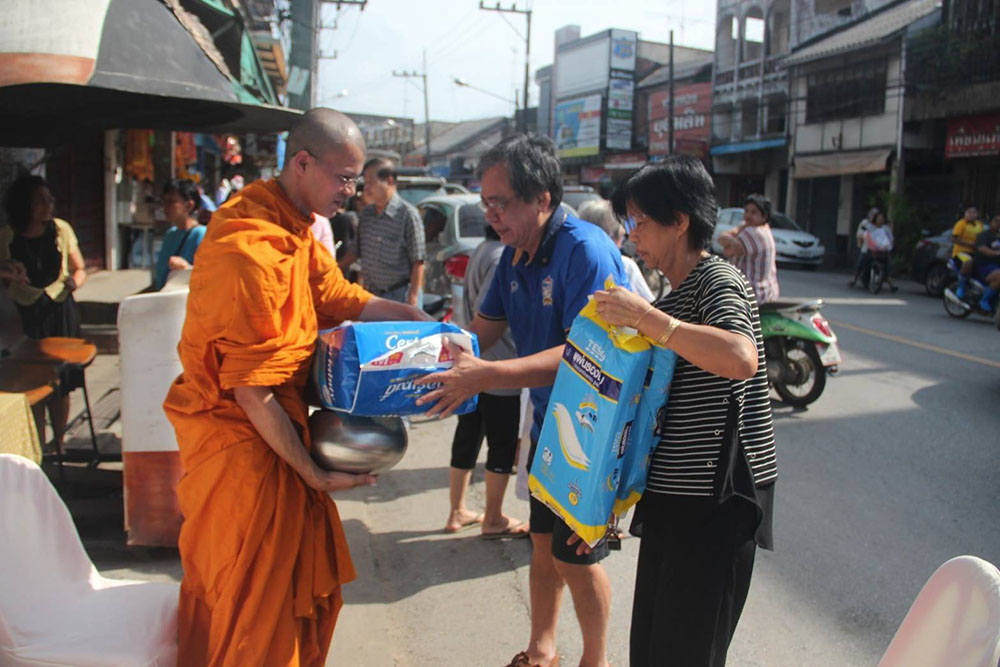
A portion of the medical equipment and food received was stored at the hospital and the rest with the collective. Requests for the supplies from sick community members have to first be authorized by the hospital, as sick individuals living at home can also borrow various kinds of equipment, such as hospital beds, from the public health system — they simply have a long wait ahead of them. If the hospital and the collective decide that there is an urgent need, such as if a patient may pass away before a hospital bed arrives, or if a paralyszed individual becomes comatose and needs an adjustable bed, then the collective will immediately provide support and take care of registration with the public health system. Once someone receives a bed from the hospital and later returns it, other members of the community can continue to use it.
As the scope of the collective’s work continued to expand, the sermon hall at the top of the Wat Huai Yod, which was used as an office, events space and storage room, became impractical and the collective asked for permission to move the sermon hall into the building which had until recently been the children’s centre. They renamed the new space the “Centre for Learning and Healing”. It is well-suited for a range of purposes: volunteer training, as well as community-organised meetings and activities, such as a meeting on waste management in the community, or a summer camp for novices. The room is also used to store supplies and medical equipment from oxygen machines and trolleys to walking sticks and mucus suction pumps.
In addition to directly distributing food and medical equipment to the sick, the Yellow Robe Collective also worked with Huai Yod, organisations and local politicians to fundraise for medical equipment for the Arokayasala Centre and the Huai Yod hospital’s emergency room. With the goal of involving the people of Trang in supporting Huai Yod’s patients, they organised a dharmayatra (buddhist pilgrimage) over a distance of 29km from Trang to Huai Yod hospital in November, 2017. The dharmayatra procession was composed of hospital staff, monks, volunteers, local organizations and schools, and stopped at nine locations to rest, collect donations and recite the buddhist scriptures. The next day, the group walked from Wat Huai Yod to a robe offering ceremony at Huai Yod hospital, where there were a thousand community members in attendance. The event raised much more money than expected, and was able to sponsor the necessary medical equipment for Huai Yod hospital. Equally importantly, the event galvanized community support for the sick, and brought the collective into the lives of a fair number of people who have since become committed volunteers of the collective.
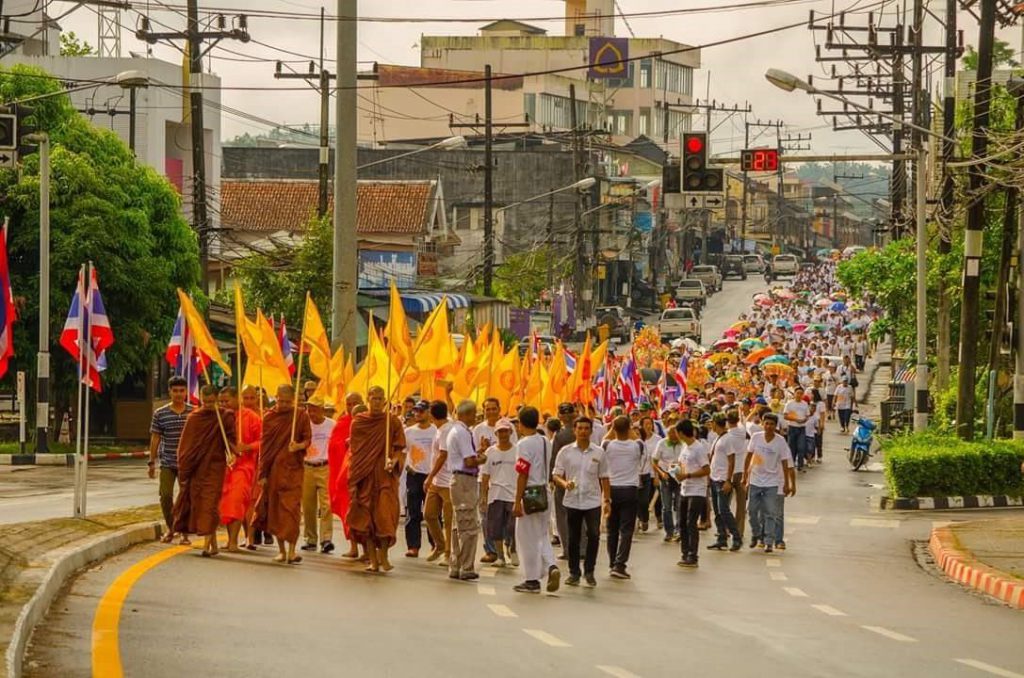
8 Communities, 8 Days of Healing
An activity that has been essential to driving the Yellow Robe Collective’s work in community-based patient care towards their declared goal of comprehensively visiting patients in the entire Huai Yod prefecture has been their visits to bedridden and housebound patients in the eight communities surrounding Wat Huai Yod. The collective worked in concert with the Huai Yod municipality and various organisations, such as the Huai Yod hospital, which sponsored health checkups, and the community public health team. The collective assembled doctors, municipal public health officials, caregivers for dependent seniors, health workers, the tambon health promoting hospital, public health volunteers, general volunteers, monks and most importantly, students from five schools in Thesaban district, with the objective of facilitating collective learning about caregiving work and patient visits. The participants were divided into two teams of twenty that each visited ten patients’ homes a day. These visits also helped familiarize them with the community.
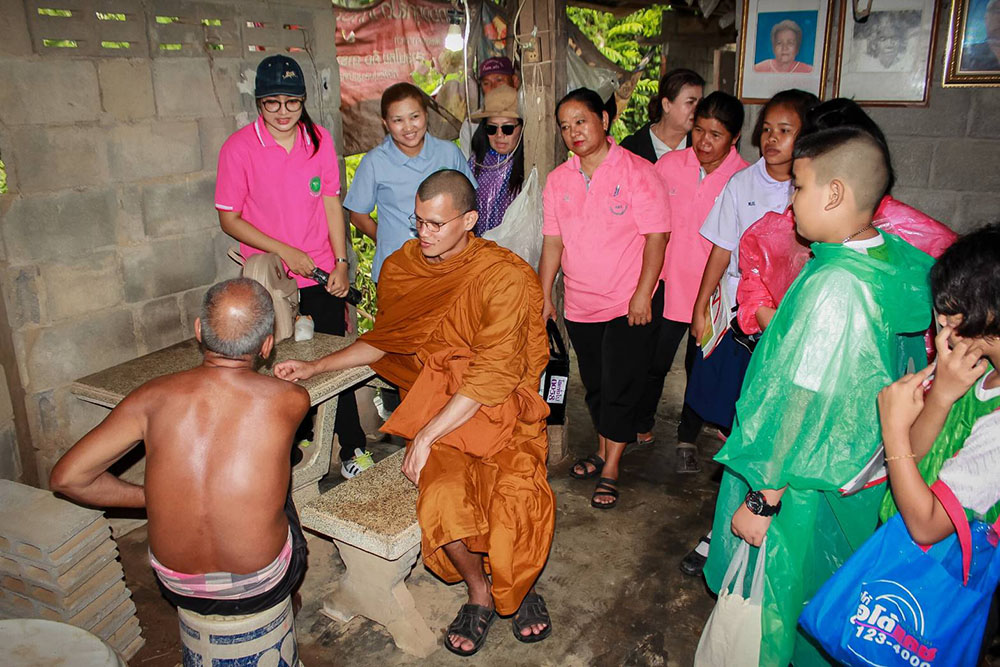
The 8 Communities, 8 Days of Healing event not only fostered connections among community organisations through the participation of volunteers, but placed a special emphasis on the youth who would play a central role in connecting visiting teams with patients. Before going into the community, the team reviewed methods of caring and interacting with bedridden seniors. Upon arriving at the patients’ home, the student enters first to greet and talk to the senior patient, which lifts the patients’ spirits more powerfully than even the presence of a monk. The collective asked the schools to send students who live in the same community as the senior, or a neighborhood close by, so that the patient feels more comfortable with the team. These students are given the opportunity to learn about patient care and ways of living in community, which aren’t taught in schools. Once the project ends, they will know which of the homes have sick residents, and public health volunteers who look after sick community members can contact the students and ask them to continue to visit. Students will develop a sense of social responsibility, while the community will realize and see that their youth are capable of taking on serious roles in the community rather than simply running around and playing.
The public health volunteers usually have a few members who mediate and co-ordinate support between patients and the Yellow Robe Collective until the patient passes away. When that happens, the collective usually hosts the funeral prayers. Providing support throughout the process builds bonds between the collective and the patients’ families. Some family members even return to volunteer with the collective after their relative passes away.
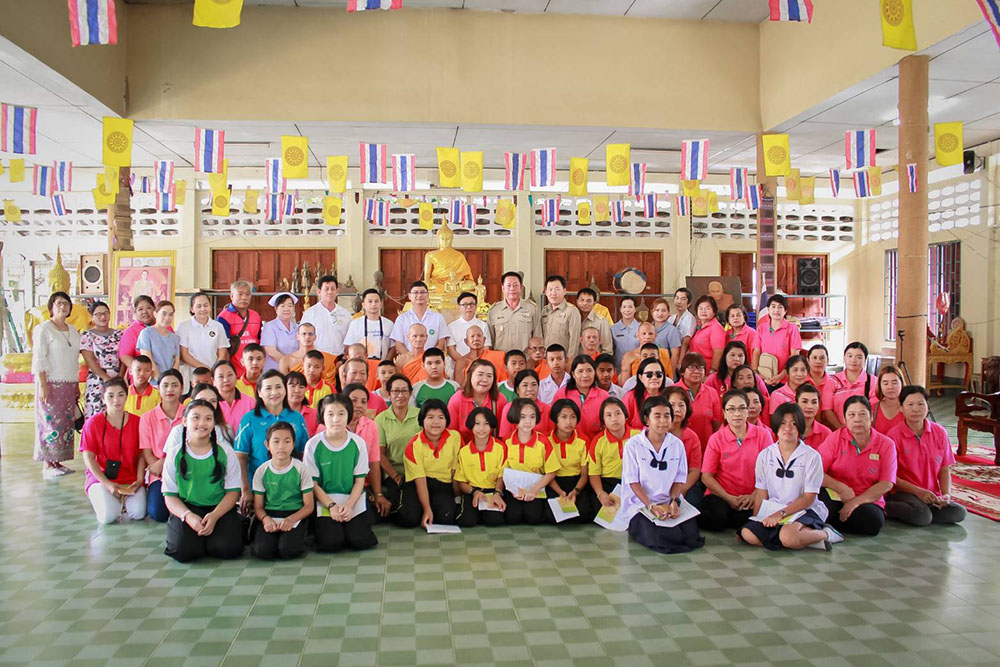
Visiting patients in the eight communities helped the collective discover and learn from seniors in different contexts. In some families, the patient lives alone; other families are warm and tight-knit, with good relationships between relatives. This is all important information that can help the collective refine their patient care in communities moving forward.
From the perspective of Barmida Liawopathanaphong, a caregiver under the Huai Yod municipality, “the project provided a lot of spiritual healing”. “Some of the patients had not been able to go to the temple at all,” she says, “because they were bedridden at home. It’s very difficult for them to go to the temple or have a monk visit them at home. Some of the patients shared that they felt as if they had received a blessing, that they hadn’t been forgotten, because the monks also invited other volunteers, medical staff and students to visit them. This gave them encouragement — some even cried, because no one had come to their house in a long time. When the monk spoke with them, it was as if they received some kind of spiritual fulfilment.”
“It is safe to say that the 8 Communities, 8 Days program was a success,” reflects Phra Krodsada. “There are many requests for us to organize another one, and next time, we’ll expand from data-collection and patient visits to facilitating collaborations between community organisations, and connecting patients with organisations that can truly help them. For example, there was a disabled old man who was in need of a prosthetic leg. He had an appointment at the hospital, but didn’t have a car, so he couldn’t go to the hospital and get himself fitted for a prosthetic. Once the collective found out, and arranged a few conversations, the municipality directly responsible for his community sent one of their cars to take him to his appointment. They were able to provide help and continue keeping an eye on the man with ease. We had to give that extra push to get the responsible organisation to do their job. We take them into the community, and show them where and how they need to provide help. Though it’s a little slow, it’s still better than nothing”.
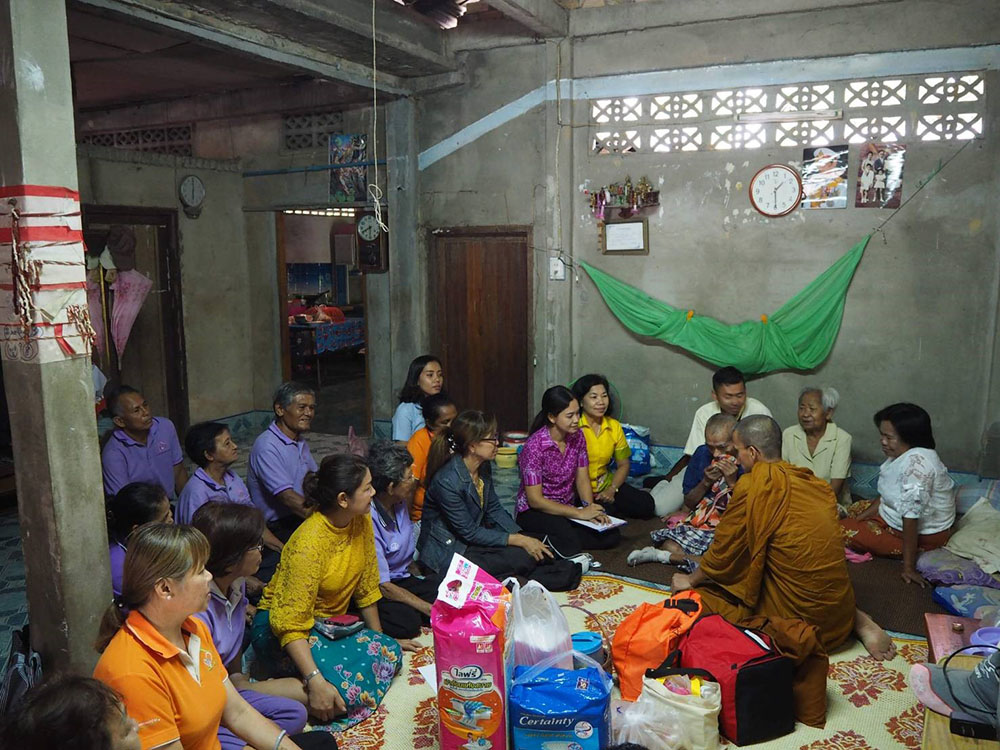
Over the last two years, the Yellow Robe Collective’s efforts have helped an ethic of helping one another to naturally grow beyond the communities it works in. Most recently, two private schools participated in the 8 Communities, 8 Days of Healing project, and began sending teams of students to visit patients in hospitals during New Years. The collective hadn’t had to reach out to them in any way. This illustrates Phra Krodsada’s observation that an essential pillar of all of the collective’s work is to “build an understanding of community participation as the practice of coming back to help one another”. The collective has facilitated structures and processes that have allowed local communities and society to come together on the foundation of providing care for end-stage patients, who experience the greatest suffering known to man. The different processes that comprise patient care are thus a way of weaving a community together. Every project builds on the one before it, and all are part of the process of healing and nurturing the health of a community. After all, collective care is the fabric that binds local communities and organisations together.
Interviews conducted:
- Phra Krodsada Khantigaro, president of the Huai Yod Yellow Robe Collective in Service of End-stage Patients
- Darunee Chanachai, a professionally-trained palliative care nurse at the Arokayasala centre, Huai Yod hospital
- Barmita Liao Phatthanaphong, a village health volunteer, caregiver and assistant of the Yellow Robe Collective
Photographs:
- FB: Phra Krodsada Khantigaro, the sangha of spiritual healing
- The Yellow Robe Collective in Service of End-stage Patients
- Arokayasala centre, Huai Yod hospital
ef for a suffering individual in an instantaneous and rather miraculous



